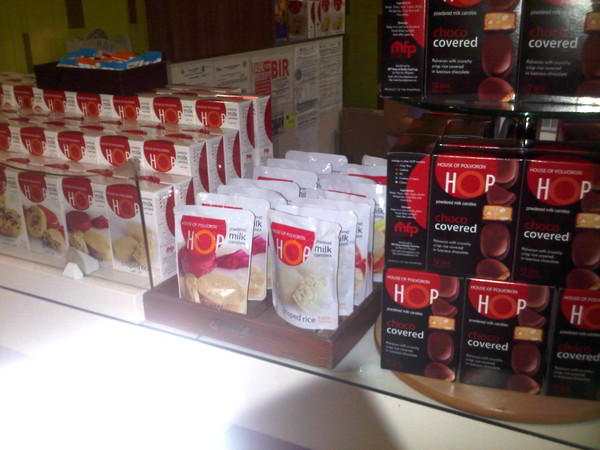The story of the House of Polvoron is one that strikes a chord among readers simply because it’s a story of triumph borne out of hard work. It’s that often told tale of how a small family business grew from strength to strength to eventually emerge as one of the market leaders in its field. Ma. Aurora F. Marcelo tells us how.

Like most businesses in the Philippines, MFP Home of Quality Food Corporation, makers of the widely popular House of Polvoron (HOP), started as a two-man enterprise in the late 1980s with the matriarch Rose Caliwara making and selling polvoron in her mother’s kitchen while her husband Ding Caliwara handled delivery and production. Polvoron is a popular Filipino dessert made with toasted flour, powdered milk, sugar and melted butter, tossed in special ingredient such as cashew nuts, crisped rice, and others, then pressed in a special mold.
At the start, the Caliwara couple sold their polvoron in schools, factory cafeterias and offices in southern Metro Manila. They did not even have a brand name yet until the year 2000 when the couple’s eldest child Charlotte joined the business. “House of Polvoron” (HOP) was coined from Charlotte’s school project at the Asian Institute of Management. By 2002, HOP was not only sold at the SM Snack Exchange and in Robinson’s Supermarket but also was able to break in at SM Megamall Hypermarket.
Widening market, improving product
HOP’s popularity rests in its melt-in-your-mouth goodness. Christine, one regular customer attests, “Malasa talaga. Alam mong hindi tinipid ang ingredients” (It is really tasty. You can tell that that only finest ingredients were used). The polvoron brand also comes in a number of varieties: crisp rice, classic, cashew, cookies and cream and pili flavors.
With a bigger market to supply, the company knew that it needed to boost its output by transitioning from a manual to a mechanized operation. Thus MFP sought DOST’s help through the Small Enterprise Technology Upgrading Program (SETUP), first in 2004 for package development, and in 2005 to acquire the necessary equipment and technical trainings to realize MFP’s first phase of productivity and quality improvements.
DOST’s Innovation System Support for the company included a kettle with scraper type mixer for melting butter, ribbon mixer for mixing wet and dry ingredients, automatic band sealer for secondary packaging of the polvoron in pouches, and a shrink packaging machine for packaging polvoron in boxes.
“Since the intervention (from DOST), our employees are happier and more productive, because they do not have to do things manually as before,” said Charlotte Caliwara, now MFP’s operations head.
In addition, experts from DOST-NCR and DOST’s research and development institutes organized trainings on food safety and MPEX. Marilou Tymiko, production assistant supervisor, welcomed the changes brought about these trainings. “Noon, pwede kaming magtrabaho nang nakashort at sleeveless lang. Ngayon mayroon na kaming bagong pamamaraan na nakuha namin sa mga trainings,” she said. (Before, we can just wear shorts and sleeveless shirts to work. But now, we have a new system that we have learned through the trainings from DOST).
Powder puff up
DOST’s comprehensive package of assistance produced remarkable results. With a bigger production output, the two-man company became a 63-staff strong family corporation. From a 200-square meter facility adjacent to the owner’s house, MFP is now housed in a 3-storey, 910-square meter facility in Las Piñas in compliance to Good Manufacturing Practices (GMP) requirements. MFP too was able to raise its production output by 138 percent and, of course, its revenue. Another notable impact of DOST’s technical interventions is the significant extension of the product’s shelf life from three months to one year.
MFP holds both a GMP and a Halal certification, and is targeting to have a HACCP certification by end of 2013. To date, MFP has already established its own R&D laboratory with the aim of producing more variants of polvoron. More important, MFP products are now being sold in 12 international markets, namely US, Canada, Saudi Arabia, Malaysia, Singapore, Netherlands, Korea, Taiwan, Japan, China, Australia and the United Arab Emirates.
More products in line
With a tougher international market to please, HOP applied for a second phase of assistance from DOST in 2012 to mechanize its remaining manual operations. At the same time, the company continued to innovate, adding three more varieties to its polvoron line: purple yam, choco covered and sugar free.
It comes as no surprise then that in the last three years, HOP was able to maintain a seven percent growth rate among its existing domestic customers. Aside from a growing number of distributors nationwide, HOP bagged major retailers like SM Supermarket, Hypermarket, SaveMore, Rustans and Shopwise.
So how did all these come about from that sweet little treat called the polvoron from one mother’s kitchen? As is often said, a good product is its own best advertisement. And the House of Polvoron can really stand proud for elevating the simple polvoron into a sought after proudly Pinoy delicacy.

